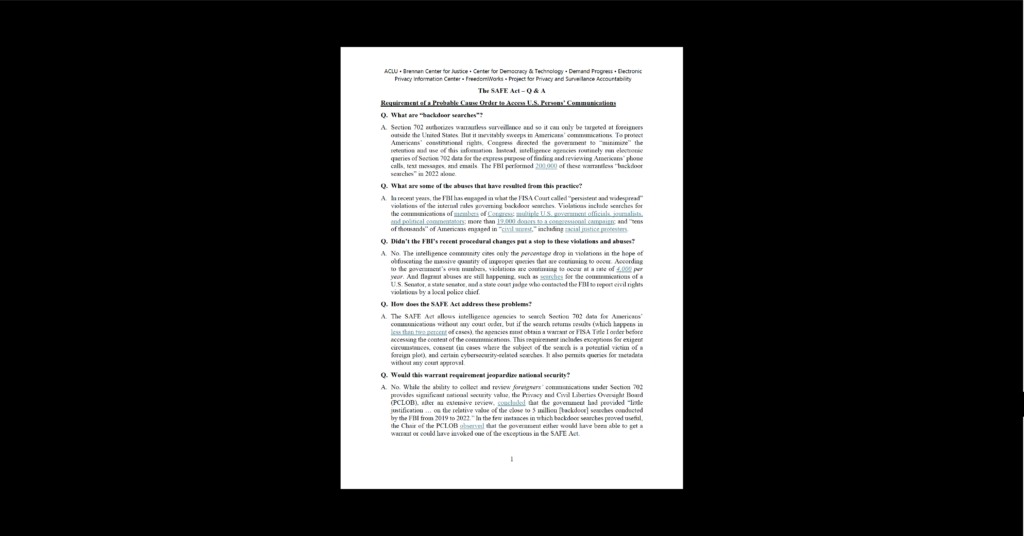Government Surveillance, Privacy & Data
Mass and Intrusive Surveillance of Immigrants is an Unacceptable Alternative to Detention
by CDT intern Emma Li.
In May, Mijente, a self-described “political home for Latinx and Chicanx people who seek racial, economic, gender and climate justice” released a report entitled “ICE Digital Prisons: The Expansion of Mass Surveillance as ICE’s Alternative to Detention.”
The report urged lawmakers to end immigrant detention, including non-traditional forms of detention. These alternatives include such substitutes as having Immigration Customs & Enforcement (ICE) agents show up unannounced to immigrants’ homes and workplaces, implementing facial and voice recognition technology, and using GPS tracking on immigrants to constantly monitor their locations, among others. The report also discusses what are called “digital prisons,” which can be used in both immigration and carceral contexts based on ICE’s assessment of how risky it would be to release an individual, and involve the use of “biometric wearables,” such as ankle monitors.
CDT stands with our allies in rejecting the use of mass surveillance as the default alternative to detention. While physical walls and detention centers have marked histories of brutality, “smart” surveillance alternatives such as ankle monitors make it far too easy for ICE to infringe on people’s rights such as privacy and free expression and can exacerbate inequities.
Using ankle monitors to track detailed location information presents clear risks to privacy. Such data could paint a picture of how people live their lives – where they receive medical treatment, go to school, worship, or buy groceries. ICE has a legitimate interest in having immigrants to the United States show up to their immigration hearings and being able to determine the location of immigrants who do not show up to their hearings or other check-ins. However, that interest does not justify ICE’s tracking and storage of the minutiae of people’s movements. Ankle monitors are, by their very design, intended to keep track of exactly where people go and how much time they spend in any given location, both of which provide data that goes far beyond the scope of what ICE needs to know and are thus overly intrusive. To the extent that ICE uses ankle monitors, there should be clear limitations on what location data they can track and the purposes for which they can use that data.
For example, ICE has unjustifiably used this surveillance to target locations that are frequented by undocumented immigrants. In August 2019, ICE was able to use GPS information generated by ankle monitors undocumented immigrants had been compelled to wear to raid food-processing plants. This led to the arrest of nearly 700 people, including many who had committed no crimes and therefore are not otherwise prioritized for removal.
Some ankle monitors are also capable of recording people’s conversations. This raises major 4th and 5th Amendment concerns because, in most cases, the people who are being recorded did not consent to have their conversations recorded. The fact that certain ankle monitors have these capabilities, even if they are not activated or used, may still result in a chilling effect where people are afraid to speak freely for fear of their speech being recorded. ICE should not be permitted to employ ankle monitors with recording capabilities.
Beyond the privacy issues, ankle monitors can exacerbate inequities. For example, the cost of such ankle monitors can be prohibitively high for their immigrant users. In one instance, one person had to pay $300 upfront in order to even use the ankle monitor. Immigrants to the United States and people who have just been released from jail or prison may not have stable jobs or sources of income. Requiring such high fees for just a month’s use of an ankle monitor would almost certainly prevent people who are not able to afford several hundred dollars out of pocket from even having the option of choosing digital detention over traditional forms of detention. This highlights systemic inequities and risks the exploitation of poor communities of color.
The technology used in ankle monitors is also far from flawless. They can be prone to glitches that may send the monitoring companies false positives, a mistake that could easily send a parolee back to prison. Officers in several states who were supposed to be monitoring wearers’ locations have ignored or otherwise missed alerts that the device had failed.
CDT rejects the idea that the best alternative to replacing the Trump administration’s physical wall is to implement “smart” surveillance walls or other systems for surveilling immigrants. As our allies have pointed out, the American immigration system is deeply flawed and incredibly outdated, and the demographic makeup of immigrants today consists of significantly more children than it did decades ago, a difference that requires a restructuring of the existing immigration laws. Mijente’s report called attention to some of these issues and more, but it is crucial that policymakers are aware that their choices are not limited to physical detention or so-called “smart” surveillance. Lawmakers should move away from this false binary. Instead, the end goal should be to create the most humane immigration system possible, and more intrusive surveillance is not the answer.


